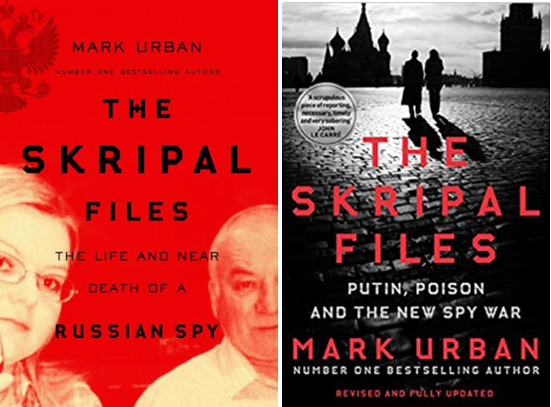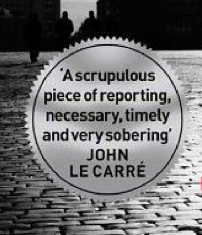Skripal Scoop - BBC Passed MI6 Lies to Bellingcat and Then Reported Bellingcat Claims As Truth
by John Helmer - Dances with Bears
@bears_withJanuary 19, 2020
In September of 2018, BBC reporter Mark Urban (lead image, left) ended his book The Skripal Files with a report of the favour MI6 had arranged, so that he could visit Sergei Skripal’s house in Salisbury, and report that a souvenir of British country life which MI6 agent Pablo Miller had presented to Skripal after his recruitment as a double agent, was still on a shelf in the living-room. For a double agent, that was a bad slip – not Skripal’s, Urban’s.
Moscow - The British Government and their media have labelled that an assassination scheme by the Russian military intelligence agency GRU, on the orders of President Vladimir Putin. They lacked the evidence of the weapon until police claim to have discovered a fake bottle of perfume in an apartment, several miles away and four months after the Skripal attack. In the second incident, Dawn Sturgess and her companion Charles Rowley exposed themselves to the bottle’s contents, allegedly the nerve agent Novichok. Rowley has been unable to explain how he came by the bottle; the police have been unable to explain why they failed to discover the bottle in full view on the kitchen table for eleven days after the incident; three days after Sturgess’s death.
The Wiltshire county coroner, David Ridley, recently announced he accepts the government’s allegations but he will not hold an inquest to test the evidence, or call the Skripals to testify; for details, read this.
Urban has divulged that he was introduced by MI6 to Sergei Skripal in 2017, the year before the attack. Miller, Skripal’s original handler, was also living nearby in Salisbury. In the 1980s Urban was a subaltern in the British Army alongside Miller, before Urban went to the BBC, Miller to MI6.
Urban interviewed Skripal at home in the summer of 2017, telling Skripal he was planning to write a book on Russian espionage. Skripal allowed the interviews for a time but then cut them off; he has refused to speak to Urban since. Urban also concealed his contact with Skripal from the BBC until some time after the attack became headline news. The book was published to tie up the loose ends of the case the government will not take to court.

On the last page of his book Urban wrote:
“On a shelf in the living room the little model cottage that Richard Bagnall [Miller] gave to Sergei back in 1996 still sits. Even after everything, it carries its promise of a better future, a happier one in that mythical place where a man’s home is his castle. This English Eden is a vivid, imagined world, where an old colonel might while away the days of his autumn, relishing happy memories of Kaliningrad, Fergana, or Malta, free from the ugly brutality of those who rule his mother country.”
For this to be the truth, for Miller’s souvenir to have remained in its pride of place less than six months after the attack, and for it to be safe for Urban to contemplate everything on the spot, Urban’s construction of the Russian assassination scheme to poison Skripal by attacking his house was impossible. It took Urban and his handlers several months to realize. Early in 2019, he says he met the head of MI6 Alex Younger (lead image, 2nd from left) and they had a conversation about the Skripal case. Younger, claims Urban, said that against the Skripals there is “still a standing threat from the GRU and the GRU and other Russian services, and that very little is off limits.”
Urban had to change the new ending of his story in order to fit the old plot. “The Skripal Files, The Life and Near Death of a Russian Spy”, published on October 2, 2018, became “The Skripal Files, Putin, Poison and the New Spy War”, published on September 19, 2019. There have been no reviews of the second book; the English media haven’t noticed the difference between them.
 What had happened, Urban rewrote, was that on the evening of the attack, March 4, 2018, Bailey and two other Wiltshire policemen had come in the front door of the house – Urban had earlier reported that Bailey entered by the back door – and “unwittingly begun the spreading of traces of Novichok around Skripal’s home. Their gloved hands had touched the door handle and feet had picked up traces of the gel that dripped down onto the threshold.”
What had happened, Urban rewrote, was that on the evening of the attack, March 4, 2018, Bailey and two other Wiltshire policemen had come in the front door of the house – Urban had earlier reported that Bailey entered by the back door – and “unwittingly begun the spreading of traces of Novichok around Skripal’s home. Their gloved hands had touched the door handle and feet had picked up traces of the gel that dripped down onto the threshold.”On March 6, Urban reports being told by his sources, “a further visit by special forces soldiers…to conduct a more thorough search is now assessed [by MI6] to have been responsible for transporting more Novichol [Urban’s misspelling] contamination around inside Skripal’s home.”
Urban’s rewrite fails to explain how the boots and gloves of Bailey and the Army troops who followed him could have poisoned the decoration on the living-room shelf. According to Salisbury Hospital and Public Health England public notices of March 2018, the decontamination procedure recommended for locals who thought they may have come in contact at the car park, riverbank, restaurant, pub and bench where the Skripals had been, was this: “Wipe personal items such as phones, handbags and other electronic items with cleansing or baby wipes and dispose of the wipes in the bin (ordinary domestic waste disposal) … Please thoroughly wash your hands with soap and water after cleaning any items.”
Decontamination of the Skripal home took a year, Urban now admits, so he was obliged to remove himself from the house first, then get rid of Miller’s keepsake. In the book, that is, not in the record Urban had already made of himself inside 47 Christie Miller Road. “In one of the sealed bags transported from Sergei’s home,” Urban reports in the penultimate paragraph of his rewrite, “was the little model cottage that Richard Bagnall gave to Sergei back in 1996.”
“Several months after the poisoning a decision was taken that there was no hope of decontaminating all of Sergei’s personal effects. So at an incineration site in southern England, bag after bag were fed into a furnace. The cottage, like so many other tokens of his earlier life, was consumed by fire.”
 Urban doesn’t acknowledge the lucky save he and a score of police, Army and MI6 men must have had in the days and weeks they moved through the house without contaminating themselves; or explain how that was possible. The outcome, according to the blurb (right) attached to the new book from David Cornwell (John Le Carré), is “a scrupulous piece of reporting”. When he was asked this month to clarify how he had determined this, or was he guessing, Cornwell/Le Carré wouldn’t say. To lie for MI6 Le Carré wants to avoid being caught at.
Urban doesn’t acknowledge the lucky save he and a score of police, Army and MI6 men must have had in the days and weeks they moved through the house without contaminating themselves; or explain how that was possible. The outcome, according to the blurb (right) attached to the new book from David Cornwell (John Le Carré), is “a scrupulous piece of reporting”. When he was asked this month to clarify how he had determined this, or was he guessing, Cornwell/Le Carré wouldn’t say. To lie for MI6 Le Carré wants to avoid being caught at. Skripal had realized Urban had been doubling for MI6, not reporting for the BBC as he had introduced himself. Whether this came before the attack on March 4, or after Skripal survived it and recovered, isn’t permitted for Skripal to say. Urban was asked recently when this had happened; he refuses to answer.
When I asked Urban why he had misled Skripal at their first interview in Salisbury over a detail as small as where in Ukraine Urban’s father had been born – when Urban told Skripal that, Skripal made a Russian joke about Ukrainians — Urban refused to tell the truth. He did tell me, however, that “if you’re reviewing please make sure to use the paperback edition – which is fully updated, for example on the police investigation of the poisoning.”
What Urban meant is that he has rewritten the final chapter and added an extra one. For this extra year of work Urban’s new evidence consists of references to a source he calls “investigative website Bellingcat” and “Bellingcat’s Russian partners, an investigative outfit called The Insider”. Urban fails to identify Bellingcat as an organisation whose financing from British Government, NATO and other sources committed to information warfare against Russia is well documented; its fabrications of evidence in the case of the downed Malaysia Airlines Flight MH17 and chemical warfare in Syria have been proved by independent researchers.
In addition to his MI6 sources, whom Urban refers to as his “contacts” and “British intelligence analysts”, Urban reveals he was the intermediary between them and Bellingcat — as much the source for Bellingcat as vice versa. “Using various Russian databases Bellingcat collated this information , sharing this work with me during the preparation of this edition of the book…In the summer of 2019 Bellingcat obtained [GRU agent] mobile phone records and I worked with one of their analysts to explore them.”
It is this collaboration between MI6, Urban and Bellingcat which Urban cites for the GRU agent names, Anatoly Chepiga (Ruslan Boshirov) and Alexander Mishkin (Alexander Petrov), and other details of the two accused in the House of Commons on September 5, 2018, by then-Prime Minister Theresa May (lead image, right). Urban’s MI6 sources reportedly told him, too, that they had managed to track the GRU men on their earlier trips to the UK, as well as in London, the day before the attack. So well tracked were they, Urban concludes that “the operation was mounted in such a way …that its discovery was intentional…with the aim of showing that those who have betrayed Russia should never sleep easy.”

Left: MI6 headquarters, London; right: GRU headquarters, Moscow.
For all the precision of the British surveillance and confidence in the Russian motive, Urban’s rewrite omits the evidence accumulated by the Blogmire and others that the GRU men did not reach Sergei Skripal’s front door; that they have not been connected to the fake perfume bottle; and that the Novichok claim is unproven in the blood evidence for the two Skripals, Bailey, Sturgess and Rowley. Urban doesn’t refer to the Blogmire and other researchers by name. Instead, he dismisses them as “only the most determined pro-Kremlin voices or professional contrarians”.
Whether true or false, the Bellingcat evidence about the GRU men’s previous military careers and their travels about Europe and England, turns out to be beside the point of the criminal case that has been alleged because there is no evidence of bottles of Novichok in their hands, or their hands at the door of the Skripal house. They were decoys, intended by GRU to be spotted and followed by the British from the minute they came off their flight from Moscow, as they were.
Bellingcat and Urban have also turned them into decoys — from the truth of what really happened to the Skripals on the Sunday in Salisbury, and what has become of them now, two years later.
“We don’t want to be played by intelligence agencies,” Bellingcat front-man Eliot Higgins told the BBC on December 19.
“Do you think you have been in the past?” asked Stephen Sackur.
“I don’t think so,” replied Higgins. “Deep fakes are obviously a big issue, but it’s not such a big issue when it comes to them being used as evidence.”

No comments:
Post a Comment